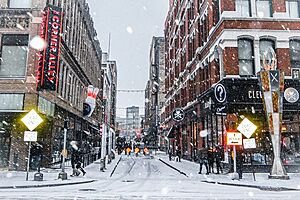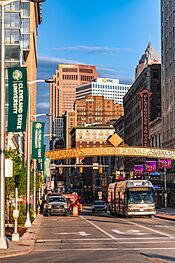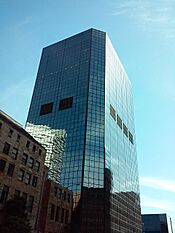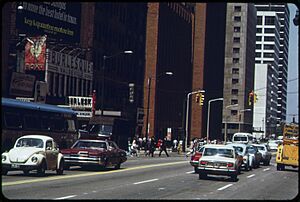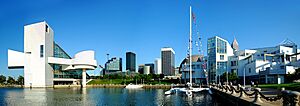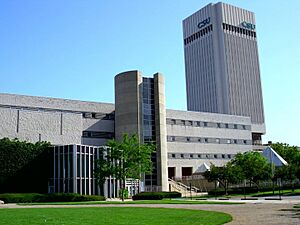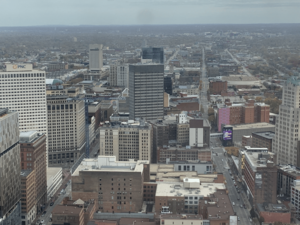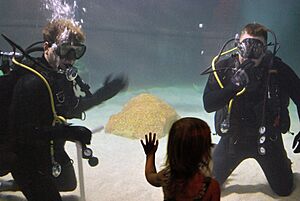Downtown Cleveland facts for kids
Quick facts for kids
Downtown Cleveland
|
|
|---|---|
|
Neighborhood
|
|
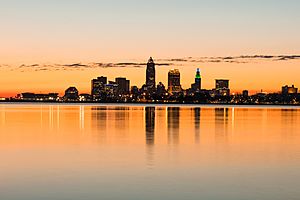
Downtown Cleveland in April 2019
|
|
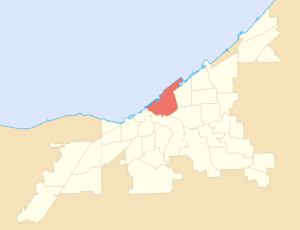 |
|
| Country | United States |
| State | Ohio |
| County | Cuyahoga |
| City | Cleveland |
| Area | |
| • Total | 3.02 sq mi (7.82 km2) |
| Population
(2020)
|
|
| • Total | ~20,000 |
| Demographics | |
| • White | 53.1% |
| • Black | 32% |
| • Hispanic (of any race) | 5.3% |
| • Asian and Pacific Islander | 10.1% |
| • Mixed and Other | 4.9% |
| Time zone | UTC-5 (EST) |
| • Summer (DST) | UTC-4 (EDT) |
| ZIP Codes |
44113, 44114, 44115
|
| Area code(s) | 216 |
| Median income | $54,834 |
| Source: 2020 U.S. Census, City Planning Commission of Cleveland | |
Downtown Cleveland is the main business and cultural area of Cleveland, Ohio, in the United States. It is the oldest part of the city. Its central area, called Public Square, was designed by the city's founder, General Moses Cleaveland, in 1796.
Downtown Cleveland is located next to Lake Erie to the north. The Cuyahoga Valley is to its west. Interstate 90 forms its southern and eastern borders. This area includes several smaller neighborhoods. It is known for its diverse buildings, including the Cleveland Mall. This mall is a great example of the "City Beautiful" design style in the United States. Many more people have moved to Downtown Cleveland since the 2000s. It has seen the biggest population growth of any Cleveland neighborhood.
Contents
- Exploring Downtown Cleveland
- Public Square: The City's Heart
- Gateway District: Sports and Fun
- East 4th Street: Food and Entertainment
- Warehouse District: Lofts and Nightlife
- Playhouse Square: Arts and Culture
- Civic Center: Government Buildings and Parks
- Nine-Twelve District: Business Hub
- Short Vincent: A Look Back in Time
- North Coast Harbor: Lakefront Fun
- Campus District: Learning and Innovation
- Superior Arts District: Creative Spaces
- The Flats: Riverfront Revival
- Downtown Cleveland's Population
- New Projects and Growth
Exploring Downtown Cleveland
Downtown Cleveland is divided into several unique areas. Each area has its own history and special features. Let's take a closer look at some of these exciting districts.
Public Square: The City's Heart
Public Square is the very center of downtown. It was designed by Moses Cleaveland in 1796. The square has stayed mostly the same since then. It is a large open space, divided into four parts by Ontario Street and Superior Avenue.
Public Square is a symbol of Cleveland. It has hosted presidents and large gatherings of people. It also hosts a free annual 4th of July concert by the Cleveland Orchestra.
In 1860, the Perry Monument was placed here. It honors Commodore Oliver Hazard Perry's victory in the Battle of Lake Erie during the War of 1812. The Soldiers' and Sailors' Monument is also in the square. It remembers people from Cuyahoga County who served in the Civil War. You can also find statues of Moses Cleaveland and a famous mayor, Tom L. Johnson. The square has lots of plants and a big public fountain.
Important buildings around Public Square include the Terminal Tower, which is part of Tower City Center. There is also Key Tower, the tallest building in Ohio. The historic Old Stone Church, built in 1855, is also here.
For many years, from the late 1800s to the 1980s, Public Square was a major shopping area. Big department stores like Higbee's were located along Euclid Avenue. This area was one of the largest shopping districts in the country. Today, many of these old department store buildings have been turned into popular apartments. The former Higbee's building is now home to the Jack Cleveland Casino.
Gateway District: Sports and Fun
The Gateway District became a lively area in the 1990s. This is when the Gateway complex was built. It includes Progressive Field and Rocket Mortgage FieldHouse. These are the homes for Cleveland's major sports teams: the MLB Cleveland Guardians, the NBA Cleveland Cavaliers, and the AHL Cleveland Monsters.
The sports stadiums are connected to Tower City Center. You can also reach them by the RTA's rail system through a covered walkway. This neighborhood also has shops, homes, and many different restaurants.
East 4th Street: Food and Entertainment
East 4th Street is a very popular street for dining and entertainment. It is close to Prospect Avenue, which was once known as Cleveland's "Radio Row." On East 4th, you'll find the House of Blues and Iron Chef Michael Symon's Mabel's BBQ restaurant. There's also a comedy club called Pickwick and Frolic. Many other restaurants and shops line the street. Hundreds of people live in apartments and lofts above these businesses. East 4th Street is also near the historic Cleveland Arcade, which was the first indoor shopping mall in the United States, built in 1890.
Warehouse District: Lofts and Nightlife
The Warehouse District was first a residential area. Then, during Cleveland's industrial growth, it became a place for warehouses and shipping. In recent years, it has changed again. Now, it is a busy area with entertainment, dining, and homes. It is the largest downtown neighborhood by population. It continues to grow with many shops, clubs, bars, and loft condos or apartments. West Sixth Street is known as the main part of this district. The 17-story Rockefeller Building, built by John D. Rockefeller, is a famous landmark here.
Playhouse Square: Arts and Culture
Playhouse Square is downtown's cultural center. It is the second-largest performing arts complex in the U.S. The area has five historic theaters built in the 1920s: State, Palace, Allen, Hanna, and Ohio. These theaters are all close together near Euclid Avenue and E. 14th Street. There are also smaller theaters like the 14th Street Theater.
Ideastream Public Media and Playhouse Square worked together to create One Playhouse Square. This building is now a broadcast headquarters. It has TV studios, radio studios, and performance spaces. Since 2005, Ideastream's stations, like PBS station WVIZ and NPR member WKSU, have been located here. Other arts groups, like Cleveland Playhouse and Cleveland State University performing arts, are also in this district.
In 2014, the streets of Playhouse Square got a $16 million makeover. A huge 4,600-piece LED crystal chandelier hangs over the intersection of Euclid Avenue and East 14th Street. It is 24 feet off the ground. The Guinness Book of World Records says it is the largest outdoor chandelier in the world. Other new features include gateway signs, a large "Playhouse Square" sign, a fire pit, and a digital display.
Civic Center: Government Buildings and Parks
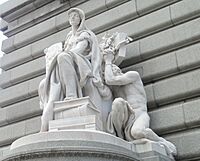
The Civic Center district is where Cleveland's government and public buildings are located. You can find the Justice Center Complex, which includes the Cleveland Police Department headquarters. Other important buildings are Cleveland City Hall, the Federal Reserve Bank of Cleveland, and the Cleveland Public Library main buildings. The Howard M. Metzenbaum U.S. Courthouse is also here.
The Public Malls (Malls A, B, and C) are green spaces and gardens. They face the lake. The Fountain of Eternal Life, a war memorial, is in Mall A. Willard Park has a famous public art piece called the Free Stamp. Fort Huntington Park has a statue of Commodore Oliver Hazard Perry and a memorial for police officers. A big new addition to this area is the Global Center for Health Innovation and Huntington Convention Center of Cleveland.
Nine-Twelve District: Business Hub
This area, around East 9th Street, is Cleveland's financial district. Many companies in finance, business, law, and media have their offices here.
The buildings in this area are mostly large, glass office towers. They were built from the 1950s to the 1980s. The tallest is Erieview Tower, which is 40 stories high. The Galleria was added to the tower in the 1980s. It was a shopping mall, but now it has shops, offices, and a food court. One Cleveland Center is a 31-story building known for its unique shape. The main church for the Roman Catholic Diocese of Cleveland, the Cathedral of St. John the Evangelist, is also in this district. Many high-rise apartments are located here, especially around East 12th Street.
Several TV and radio stations have their offices in this district.
Short Vincent: A Look Back in Time
Short Vincent is a small street between East 6th and East 9th Street. It was once a major entertainment area in Cleveland. It was known for its lively nightlife.
The street's Theatrical Grill was a famous spot. It hosted many visiting celebrities like Frank Sinatra, Marilyn Monroe, and Judy Garland. The area changed and declined by the 1960s and 1970s. Many of its old buildings were torn down in the late 1970s.
North Coast Harbor: Lakefront Fun
North Coast Harbor is downtown Cleveland's tourist area. It is home to the Rock and Roll Hall of Fame and Museum, the Great Lakes Science Center, and FirstEnergy Stadium. You can also visit the Steamship William G. Mather Maritime Museum and the USS Cod submarine here.
This district is where the city's port is located. FirstEnergy Stadium is the home of the NFL Cleveland Browns football team. Burke Lakefront Airport is also in this area. It is a smaller airport for commuter and business flights. The district faces Lake Erie and includes Voinovich Park and a fishing pier. There are plans to add more homes, shops, and a marina to North Coast Harbor in the future.
Campus District: Learning and Innovation
The Campus District is a large downtown neighborhood. It is just east of the main business area. Key members of the Campus District include Cleveland State University, St. Vincent Charity Medical Center, and Cuyahoga Community College.
Cleveland State University has been working to improve its campus and attract more students. The university plans to build a "college town" next to downtown. This will include new shops, restaurants, and housing for thousands of students who live on campus. CSU is also focused on research and helping new businesses start up. The Wolstein Center, a large arena, is also in the Campus District. It hosts CSU Men's Basketball games and various concerts.
Superior Arts District: Creative Spaces
North of the Campus District is the Superior Arts District. This area was once the center of Cleveland's clothing industry in the late 1800s and early 1900s. It was second only to New York in this industry. When the clothing industry declined, many buildings became empty.
In the 2010s, people started to see the potential in this area. In 2016, the Superior Arts District officially became its own neighborhood. Today, it is a mixed-use area where artists live and work. It has apartments, bars, restaurants, and cafes.
The Flats: Riverfront Revival
The Cuyahoga River divides The Flats into two parts: the East Bank and the West Bank. While most of this area is part of the Cuyahoga Valley neighborhood, some of the East Bank is considered an extension of Downtown. The Flats are historically important because Moses Cleaveland first landed here when he founded the city. The first permanent European settler, Lorenzo Carter, built his cabin here.
For much of Cleveland's history, The Flats were mostly industrial. By the 1980s, it became a popular nightlife spot. After a decline in the early 2000s, it underwent a major redevelopment. Many old buildings were torn down. Now, an 8-story Aloft Hotel and a 21-story office tower have been built. More restaurants, apartments, and a riverside walkway are planned. The West Bank of the Flats has many homes, especially in the Stonebridge apartments and condos. The Flats are now a mix of different uses, with ongoing redevelopment.
Downtown Cleveland's Population
In December 2020, it was estimated that about 20,000 people lived in Downtown Cleveland. The 2020 census reported 13,338 people living in the Downtown area. Out of 9,569 total housing units, 7,244 were occupied. This means about 75.7% of the homes were lived in.
In 2020, the population was made up of 53.1% white people, 32% African American people, 10.1% Asian and Pacific Islander people, and 4.9% mixed and other groups. About 5.3% of the population identified as Hispanic or Latino. The average household income in Downtown was $54,834. In 2019, 17.2% of Downtown's population was born outside the United States.
New Projects and Growth
Downtown Cleveland has seen a lot of new development since the mid-1990s. Between 2010 and 2014, over $4.5 billion was invested in homes and businesses downtown. In 2000, about 100,000 people worked in the area.
Euclid Corridor: Better Transit
The $197 million Euclid Corridor Transportation Project improved public transportation. It connected downtown, Midtown, and University Circle using a special bus system called bus rapid transit (BRT), known as the HealthLine. This project rebuilt Euclid Avenue. It added special bus lanes, quick boarding stations, and faster travel times.
Besides improving transit, the project also made Euclid Avenue look much nicer. They rebuilt sidewalks, added new lighting, and planted new trees. The project also included public art along the route. These improvements are expected to bring more homes, shops, and offices to the area.
Medical and Convention Center

A large $465 million Global Center for Health Innovation and Cleveland Convention Center opened in 2013. This huge complex is 1.1 million square feet. It includes a 235,000-square-foot Global Center for Health Innovation and a 750,000-square-foot Convention Center. The Convention Center has a large exhibit hall and many ballrooms. You can also enjoy views of Lake Erie from a large patio. This project was paid for by a small increase in the Cuyahoga County sales tax. Important healthcare companies like the Cleveland Clinic and University Hospitals are permanent tenants here.
Flats East Bank: Modern Riverside Living
A large, multi-stage project worth $500 million is developing the East Bank of the Flats. This project is creating a mix of different uses.
The first part, costing $275 million, opened in 2013. It included a 23-story office tower, an 8-story Aloft hotel, restaurants, and a health club. The office tower is called the "Ernst and Young building." It has modern office spaces and a green rooftop terrace.
Two Waterfront Line Rapid stations, Settlers Landing station and Main Avenue station, also received upgrades. The work included new pavers, fixing glass shelters, and removing old ticket booths. At Settlers Landing, etched glass panels showing Cleveland's history were restored.
Flats West Bank: New Attractions
A $33 million Greater Cleveland Aquarium opened in 2012. It is located in the historic FirstEnergy Powerhouse building. It is the only standalone aquarium in Ohio. The aquarium has over a million gallons of water in 42 tanks. Its main feature is a 145-foot-long clear tunnel called a Seatube. The aquarium was built to fit the old building's unique design.
Jacobs Pavilion at Nautica is an outdoor concert venue with 5,000 seats. In 2012, it got a $1 million upgrade. This included a new entrance and an expanded riverfront area.
In 2010, a partnership bought seven acres of land along the river. They are turning it into Rivergate Park, a new recreation center in the Flats. The park opened in 2011. It allows public access to the Cuyahoga River for activities like kayaking and rowing. Plans for the future include a launch area for boats and public restrooms.
Cleveland's Crooked River Skate Park is planned to be built on city land next to Rivergate Park. It will be 15,000 square feet.
Cleveland State University Expansion
CSU's campus continues to grow with a $500 million expansion. Recently, a new Student Center ($55 million) and new dorms called Euclid Commons ($60 million) were completed. A "College Town" area with 373 new homes for students was also built.
Future projects include turning the historic Mather Mansion into a small hotel. A new $45 million Center for Innovation in Health Professions is also planned.
Close to campus, the Langston Apartments project is adding over 300 apartment units. The first part of this $54 million project opened in 2012.
Completed Projects
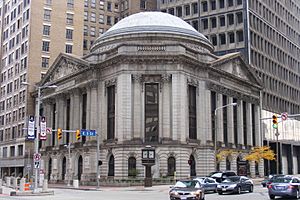
The relocation of the Cuyahoga County Administrative Headquarters is leading to a $200 million mixed-use project. This project is at the corner of Euclid Avenue and East Ninth Street. It involves the 29-story Ameritrust Tower, the 1010 Euclid Avenue building, and the historic Cleveland Trust Company Building.
A new eight-story Cuyahoga County headquarters building will be built here. The plan also includes creating 210 high-end apartments in the former office tower. A hotel is also being considered for the lower floors of the tower. Since 2015, the Cleveland Trust Company Rotunda and the ground floor of 1010 Euclid Avenue have been home to a full-service Heinen's grocery store for downtown residents.
Residential Growth
Downtown Cleveland had the biggest percentage population growth in the 2010 Census for the entire city. Many old office spaces are being turned into homes, which is causing the population to keep growing. New buildings are also adding over 1,500 new homes.
Hotels
Many new hotels have opened or are planned for Downtown Cleveland. A 150-room Aloft Hotels opened in the Flats East Bank in 2013. The 484-room Westin Hotel was renovated and rebranded in 2014.
The 600-room Hilton Cleveland Downtown Hotel opened in 2016. This 28-story tower is next to the Global Center for Health Innovation. A Marriott Autograph Collection hotel is planned for the Ameritrust complex. Other hotels like a Kimpton hotel and a Le Meridien are also expected.
The old Cleveland Municipal School District headquarters is being turned into a 175 to 180-room hotel by Drury Southwest Incorporated. It is expected to be a Drury Plaza hotel. There are also plans to convert the Cleveland Athletic Club building into a Crowne Plaza hotel.
Lakefront Development
The city often proposes plans for expanding and building along the lakefront. However, no major construction has happened since the late 1990s, except for a $17 million Coast Guard administrative building that opened in 2012.
Cleveland's most recent Downtown Cleveland Lakefront Plan, from 2012, focuses on three areas. North Coast Harbor plans new businesses and walkways connecting FirstEnergy Stadium, Great Lakes Science Center, and Rock and Roll Hall of Fame with the Global Center for Health Innovation and Convention Center. Harbor West is a new mixed-use development planned between Erieside Avenue and the water's edge. Burke Development District proposes an office campus near Burke Lakefront Airport. Building heights are limited here because of the airport.
Two projects completed in 2013 include a 53-ship marina along the East Ninth Street pier. Also, a $5.5 million pedestrian bridge, designed by Miguel Rosales, connects Voinovich Bicentennial Park to the North Coast Harbor Walkway.






